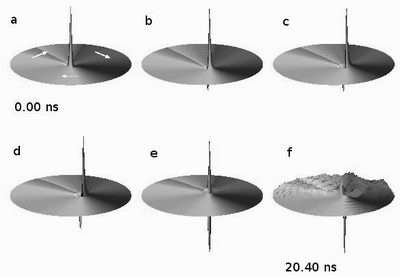April 30, 2007 feature
Manipulating Magnetism for Future Data-Storage Devices

In an important step toward future data-storage technologies based on magnetism, a research group has determined how to control the magnetization of a “magnetic vortex,” a curling nanometer-sized magnetic structure present within tiny, millionth-of-a-meter-sized magnetic disks. Understanding the behavior of this type of structure is one of the main requirements of magnetic data-storage development.
The group, led by scientists at Kyoto University in Japan, found a way to manipulate the magnetization of the vortex's core without applying an external magnetic field to the disk. Instead, they applied a current.
‚ÄúWe have taken advantage of the way the vortex responds to an applied current,‚Äù said corresponding Kyoto University scientist Teruo Ono to ¬È∂π“˘‘∫Org.com. ‚ÄúA current of the right strength resonates with the vortex, causing it to rotate at a high speed ‚Äì several hundred meters per second. This motion produces a strong dynamic magnetic field that opposes the vortex's own magnetization, and reverses it.‚Äù
Although the applied current is electrical in nature, being based on electrons, it isn't a stream of moving electrons. It is a “spin current,” a stream of moving spins. Spin is an intrinsic property of electrons that essentially imparts them with a tiny magnetic field, or magnetic “moment,” pointing either up or down. If several electrons are placed in a row, a spin can propagate down the line; many propagating spins produces a spin current.
Across the globe, teams of researchers are working to build viable spin-based electronic devices – spintronics – using spin currents. This group's work opens the possibility that simple magnetic disks can serve as the building blocks for spintronic devices like memory cells, where each bit of information would be stored as the direction of the vortex-core's field. Vortex-core switching could be an efficient way of writing data to a memory device.
The physics underlying this result is the tension created between the spin direction of the conduction electrons and the direction of the individual magnetic moments that make up the overall magnetic field of the vortex core. When they are positioned relative to each other at a specific angle, the spin current applies a torque to each moment, forcing the whole core to rotate.
“This spin-transfer effect liberates us from having to apply a large external magnetic field in order to control magnetic devices, which means we can avoid the expense and effort required to maintain such large fields,” Ono added.
This research is described in the March 18, 2007, online edition of Nature Materials.
Citation: Keisuke Yamada, Shinya Kasai, Yoshinobu Nakatani, Kensuke Kobayashi, Hiroshi Kohno, André Thiaville, and Teruo Ono, Nature Materials advance online publication, 18 March 2007 (DOI 10.1038/nmat1867)
Copyright 2007 ¬È∂π“˘‘∫Org.com.
All rights reserved. This material may not be published, broadcast, rewritten or redistributed in whole or part without the express written permission of ¬È∂π“˘‘∫Org.com.





















